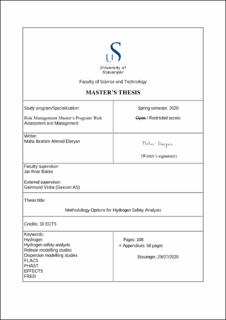| dc.description.abstract | The development of applications using hydrogen as a clean energy carrier has increased in recent years. Hydrogen is versatile and can be used in a wide range of applications. Hydrogen is already being widely used as a chemical feedstock for producing fertilizers and petrochemicals. Hydrogen can be used to power vehicles and generate heat and electricity. A prerequisite for commercial applications of hydrogen is to ensure that the risk associated with its production, storage, transport and use is at least not significantly higher than that of existing fuels. Hydrogen is not inherently more dangerous than other conventional fuels, but it has quite different properties, namely very low ignition energy, wide flammability range, high laminar burning velocity and high buoyancy.
Consequence analysis is a critical part of any Quantitative Risk Assessment (QRA), which is used to predict the physical effects of the accidental release of flammable materials. A wide range of consequence analysis tools exist, ranging from simple integral tools based on empirical correlations to sophisticated three-dimensional Computational Fluid Dynamics (CFD) tools. Integral tools are easy to use and require less computational time; however, they take limited account of the influence of obstacles on the flow. Whereas CFD tools are more complex and require longer computational time (typically hours or day) and more skills, but they can predict the effect of complex geometries on the flow. Despite the intrinsic differences, CFD tools and integral tools are considered to perform the same task in consequences analysis. Uncertainties are always part of any consequence analysis, especially for emerging applications. Thus, it is important to understand the underlying assumptions and inherent limitations of the available tools, as well as the expected level of accuracy in the results for different types of hazardous scenarios.
This study examines and compares the results predicted by the CFD tool (FLACS) and integral tools (FRED, PHAST and EFFECTS) which are used in hydrogen safety studies. The focus is to show where the tools predict similar results and where their results deviate strongly. It includes a description of the physical models used in FLACS, FRED, PHAST and EFFECTS for release modelling of hydrogen gas leak through an orifice from a pressurized storage tank. Release and dispersion simulations are carried out in each of FRED, EFFECTS, PHAST and FLACS for 81 hypothetical hydrogen gas release scenarios in open flat terrain. Then, sensitivity analysis is performed with variations in input parameters such as orifice size, wind speed, release direction, atmospheric stability class and surface roughness length to study their effect on the dispersion of the gas cloud. Finally, dispersion simulations are carried out in FLACS for hydrogen gas release from a dispenser in a refuelling gas station and its corresponding release scenario in open flat terrain to study the effect of obstacles on the dispersion of the gas cloud.
A comparison tool was developed using the results produced by the four tools for 72 hydrogen gas release scenarios. The comparison includes the mass flow rate, the downwind distances to lower flammability limit (LFL) and half of lower flammability limit (½ LFL), and the amount of flammable mass between upper and lower flammability limits. The results showed that FLACS, FRED, EFFECTS and PHAST predicted almost the same mass flow rates for hydrogen gas released at 5 bar and 25 bar; however, FLACS predicted higher mass flow rates compared to the other tools for hydrogen gas released at 350 bar. The results of the dispersion simulations conclude that EFFECTS is not recommended for hydrogen safety studies due to the large discrepancies in the results when compared to FLACS, FRED and PHAST. FLACS predicted longer downwind distances to LFL and ½ LFL, and larger amount of flammable mass for most of the considered release scenarios; however, the results need to be compared against experimental results as it is not possible to recommend the use of one tool over the other based only on the results of this study.
Hydrogen buoyancy does not prevent the formation of a large flammable cloud. The common argument is that a release of hydrogen gas in an unconfined area will rise and disperse relatively quickly upon release; however, this is not always the case. Hydrogen buoyancy is only valid outside the part of dispersion which is controlled by the jet momentum. From the results, a higher initial pressure produces a jet with higher momentum and the buoyancy force takes longer to dominate the flow. Also, hydrogen gas releases near the ground, tend to deflect towards the ground and cling to it because of an effect known as the Coandă effect. The results showed that this effect increases with the increase in wind speed. Obstacles in the path of the gas cloud help in decreasing the jet momentum and allow the buoyancy to have more effect; however, a large flammable cloud can still be formed. | en_US |
